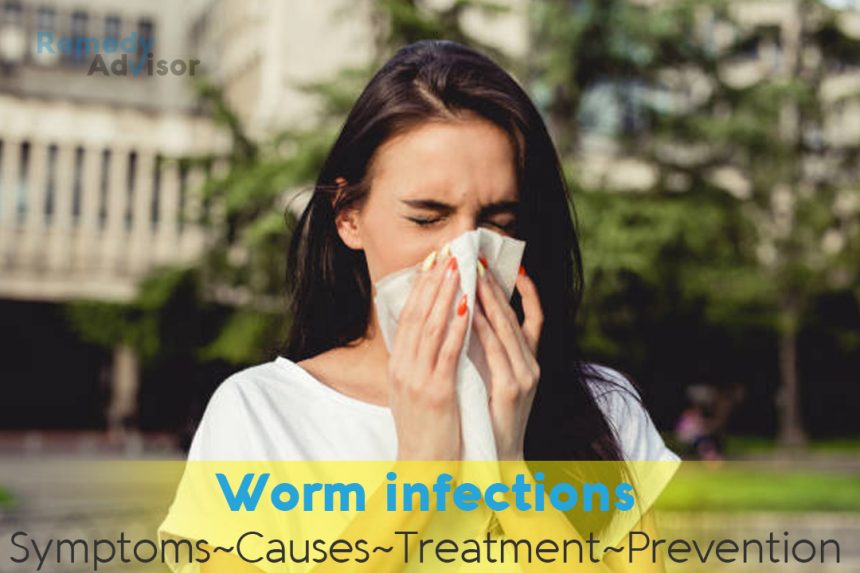What is it
Infections from worms, or helminths, are parasitic conditions that can produce major public health problems, particularly in tropical and underdeveloped countries, where they have affected large populations. Though helminthic infestations can occasionally be serious in the United States and other developed countries, usually the symptoms they produce are an annoyance rather than a health threat, and most cases clear up within a week or so with proper treatment. Unfortunately, symptoms are often so similar to other ailments that the helminthic infection may be initially mistaken for constipation, diarrhea, or irritable bowel syndrome.
Pinworms are the most common helminth infesting people in the United States. Most of those infected are children, and it is estimated that somewhere between 10 and 40 percent of children under the age of 12 have pinworms at any given time.
Members of a class of helminth called nematodes, pinworms are tiny: an adult pinworm, Enterobious vermicularis, is barely half an inch-long, with the diameter of a strand of a thread (pinworms are also called threadworms). The worms live in the large intestine (colon) of humans. When male and female pinworms mate, the female produces about 10,000 eggs. After migrating through the colon and crawling out of the anus, she deposits sticky masses of the eggs on the skin near the anal opening of the infected person. Within six to eight hours, the eggs mature. Reinfection often occurs when an infected child touches or scratches the rectal area the adult worms as well as the eggs can cause intense itching and later puts the finger or thumb (to which the eggs cling) in his or her mouth. The pinworms eggs are swallowed, subsequently hatch in the small intestine, and later move to the large intestine. The entire cycle lasts four to six weeks.
Hookworms have teeth they use to attach themselves to the intestinal wall, where they feed on the blood of the host. The worm enters the skin, typically through bare feet (especially the thin parts between the toes), and then burrows its way to the bloodstream, eventually reaching the stomach, where it can live for years. Hook-worms are most common in areas lacking adequate sanitation.
Tapeworms are a separate class of helminth, called cestodes, that are found in contaminated pigs, fish, or cattle. These worms vary in length from an inch to more than 30 feet and, once inside the human body, inhabit the digestive tract, where they attach themselves to the intestinal wall and absorb food. Tapeworms may survive in the body for years, often causing few if any symptoms.
Symptoms
Infections may produce no symptoms. When symptoms do occur, they include the following:
- Severe nocturnal itching of the anal area, causing insomnia and irritability, may indicate pinworms.
- Hookworms may produce no symptoms, but when symptoms do occur, they can include a dry cough, breathing difficulty, itching of the feet, legs, or buttocks, mild anemia, and mental and physical fatigue.
- Eggs in stool or worm segments in bedding, clothing, and stool may indicate tapeworms. Dizziness, fatigue, vomiting, unexplained loss of appetite, and weight loss may also occur.
What causes it
Most commonly, pinworms reinfect their human hosts when they become trapped under fingernails and directly reenter the host either through the mouth or through food that has been touched and contaminated. Close contact between infected and uninfected people can also help transfer pinworms, leading to infestation of other children and family members.
In addition, some pinworm eggs may be dis- lodged from the body, landing in house dust, clothing, bedding, and even the fur of house pets, where they can survive for two to three weeks. If the pinworm eggs are airborne, the eggs can be inhaled and swallowed. (Unlike man helminthic infections, pinworms are not limited to rural and poor areas but occur in various geographic areas and among different socioeconomic groups.)
Hookworms enter the skin when a person walks barefoot on soil contaminated by human feces as well as that of dogs or cats.
Tapeworm eggs enter the body when a person consumes pork fish, or beef that is incompletely cooked. The eggs can eventually hatch and thrive in the human intestine.
What if you do nothing
Mild worm infections can often clear up without treatment. Nevertheless, if you notice symptoms of worms, you should not let them go untreated. Pinworm and tapeworm infections that aren’t treated can easily spread to uninfected people. And heavy worm infestations in a child can affect the child’s growth and development as well as cause such complications as intestinal blockage and bacterial infections (due to scratching itchy skin).
The larvae of some tapeworms can also form cysts in organs throughout the body and the cysts may produce serious symptoms.
Home remedies
Some worms, such as the pinworm and tapeworm, need to be treated immediately with medication to keep them from spreading to uninfected people. Contact your physician. In the meantime, follow the preventive tips to avoid reinfestation.
Prevention
Practice good hygiene
Wash your hands with soap and water after using the bathroom, after petting your animals, and before eating. Make sure nails are kept clean and cut short.
Check pets
Have your cat and dog treated for worms regularly.
Cook food thoroughly
High heat will kill any live worms present in food. Avoid dishes with raw meat or fish, such as steak tart are or sushi.
Clean all knives and cooking utensils used with raw meat
Wash them thoroughly in hot, soapy water.
Wear shoes at all times in unfamiliar areas
Shoes will prevent contamination from hook-worm.
Choose your restaurants carefully
Don’t dine in eating establishments where you suspect unsanitary conditions.







